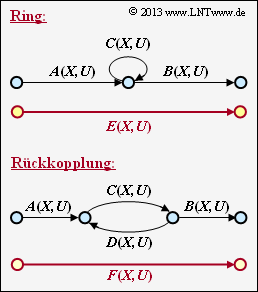Difference between revisions of "Aufgaben:Exercise 3.12Z: Ring and Feedback"
From LNTwww
| Line 20: | Line 20: | ||
===Fragebogen=== | ===Fragebogen=== | ||
<quiz display=simple> | <quiz display=simple> | ||
| − | { | + | {Welche der aufgeführten Übergänge sind beim Ring möglich? |
|type="[]"} | |type="[]"} | ||
| − | + | + | + $S_1 → S_2 → S_3$, |
| − | - | + | + $S_1 → S_2 → S_2 → S_2 → S_3$, |
| + | - $S_1 → S_2 → S_1 → S_2 → S_3$. | ||
| − | { | + | {Wie lautet die Ersetzung $E(X, \, U)$ eines Ringes? |
| − | |type=" | + | |type="[]"} |
| − | $ | + | - $E(X, \, U) = [A(X, \, U) + B(X, \, U)] \ / \ [1 \, –C(X, \, U)]$, |
| + | + $E(X, \, U) = A(X, \, U) \cdot B(X, \, U) \ / \ [1 \, –C(X, \, U)]$, | ||
| + | - $E(X, \, U) = A(X, \, U) \cdot C(X, \, U) \ / \ [1 \, –B(X, \, U)]$. | ||
| + | |||
| + | {Welche der aufgeführten Übergänge sind bei Rückkopplung möglich? | ||
| + | |type="[]"} | ||
| + | + $S_1 → S_2 → S_3 → S_4$, | ||
| + | - $S_1 → S_2 → S_3 → S_2 → S_4$, | ||
| + | + $S_1 → S_2 → S_3 → S_2 → S_3 → S_4$, | ||
| + | + $S_1 → S_2 → S_3 → S_2 → S_3 → S_2 → S_3 → S_4$. | ||
| + | |||
| + | {Wie lautet die Ersetzung $F(X, \, U)$ einer Rückkopplung? | ||
| + | |type="[]"} | ||
| + | + $F(X, \, U) = A(X, \, U) \cdot B(X, \, U) \cdot C(X, \, U) \ / \ [1 \, –C(X, \, U) \cdot D(X, \, U)]$ | ||
| + | - $F(X, \, U) = A(X, \, U) \cdot B(X, \, U) \ / \ [1 \, –C(X, \, U) + D(X, \, U)]$. | ||
</quiz> | </quiz> | ||
Revision as of 13:31, 5 December 2017
Um die Pfadgewichtsfunktion $T(X)$ eines Faltungscodes aus dem Zustandsübergangsdiagramm bestimmen zu können, ist es erforderlich, das Diagramm so zu reduzieren, bis es durch eine einzige Verbindung vom Startzustand zum Endzustand dargestellt werden kann.
Im Zuge dieser Diagrammreduktion können auftreten:
- serielle und parallele Übergänge,
- ein Ring entsprechend der obigen Grafik,
- eine Rückkopplung entsprechend der unteren Grafik.
Für diese beiden Graphen sind die Entsprechungen $E(X, \, U)$ und $F(X, \, U)$ in Abhängigkeit der angegebenen Funktionen $A(X, \, U), \ B(X, \ U), \ C(X, \, U), \ D(X, \, U)$ zu ermitteln.
Hinweise:
- Mit dieser Aufgabe sollen einige der Angaben auf Seite 4b von Kapitel 3.5 bewiesen werden.
- Angewendet werden diese Regeln in Aufgabe A3.12 und Aufgabe A3.13.
Fragebogen
Musterlösung
(1)
(2)
(3)
(4)
(5)
